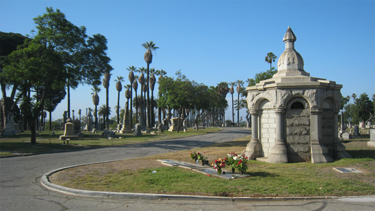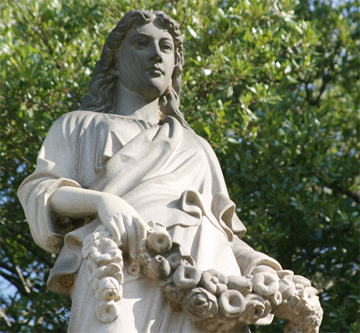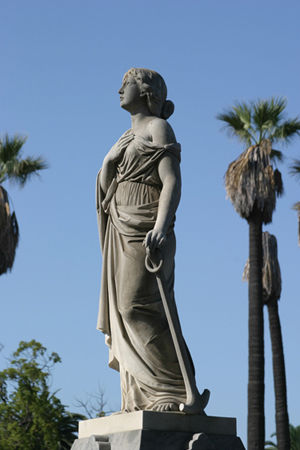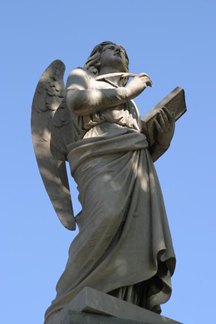Oldest Cemetery in Los Angeles
- Details
- Category: Our History
- Published on Wednesday, 26 August 2015 11:05
- Written by LAura Meyers
 Rosedale Cemetery (now Angelus Rosedale) was founded in 1884, when Los Angeles was a small town and its location at what is now the corner of Washington Boulevard and Normandie Avenue was in the countryside, outside the city limits. It was the first cemetery in Los Angeles open to all races and creeds, and it was the first to use a new approach in design called “lawn cemeteries…where nature and art conspire to surround the burial places of the dead with beautiful trees and flowers, natural scenery and works of monumental art.”
Rosedale Cemetery (now Angelus Rosedale) was founded in 1884, when Los Angeles was a small town and its location at what is now the corner of Washington Boulevard and Normandie Avenue was in the countryside, outside the city limits. It was the first cemetery in Los Angeles open to all races and creeds, and it was the first to use a new approach in design called “lawn cemeteries…where nature and art conspire to surround the burial places of the dead with beautiful trees and flowers, natural scenery and works of monumental art.”  This is how a newspaper article of the time described it:
This is how a newspaper article of the time described it:City of the Dead
What a beautiful city of the dead is Rosedale Cemetery, with its broad circling driveways, lined on either hand with graceful palms; with its emerald expanses of lawn, its growing flowers, pouring out their rich perfume, and its many elegant and stately monuments of white and colored marble…The tall monuments pointed upward to the skies and many were beautiful in design and finish. Among these [is a] particularly a fine one of rich Tennessee marble, upon the summit of which is a beautiful female figure, with angelic face turned upward…Flowers were there to smile above the silent sleepers and to proclaim that they were not forgotten. Trees are abundant in this part of the cemetery, and their leafy boughs are like hands lifted in benediction."
--Los Angeles Times, February 21, 1892
 To this day, the grounds of Angelus Rosedale are beautiful and surprisingly removed from the noise and distractions of the city. From its beginnings, the cemetery brought home members of the city’s leading families – Bannings and Glassells, Slausons and Rindges – along with California pioneers, politicians, wealthy business people, people famous and sometimes infamous for their activities in life. George and Clara Shatto, who once owned Catalina Island, are buried here. So is Caroline Severance, abolitionist and suffragette who became the first woman to cast an election vote in California. Other notables include Jessie Benton Fremont, daughter of the Missouri Governor, wife of the "Pathfinder" John C. Fremont, and a historian in her own right; Eliza Poor Donner Houghton, who survived the tragic Donner Party incident and later married a California Senator; architect Sumner Hunt, who designed both important institutional buildings and many homes in West Adams and throughout the Los Angeles area; Jean Louis Sainsevain, one of California’s first winemakers; and Rev. Asahel Hough, Marion Bovard and Robert Widney, all of whom were founders of the University of Southern California.
To this day, the grounds of Angelus Rosedale are beautiful and surprisingly removed from the noise and distractions of the city. From its beginnings, the cemetery brought home members of the city’s leading families – Bannings and Glassells, Slausons and Rindges – along with California pioneers, politicians, wealthy business people, people famous and sometimes infamous for their activities in life. George and Clara Shatto, who once owned Catalina Island, are buried here. So is Caroline Severance, abolitionist and suffragette who became the first woman to cast an election vote in California. Other notables include Jessie Benton Fremont, daughter of the Missouri Governor, wife of the "Pathfinder" John C. Fremont, and a historian in her own right; Eliza Poor Donner Houghton, who survived the tragic Donner Party incident and later married a California Senator; architect Sumner Hunt, who designed both important institutional buildings and many homes in West Adams and throughout the Los Angeles area; Jean Louis Sainsevain, one of California’s first winemakers; and Rev. Asahel Hough, Marion Bovard and Robert Widney, all of whom were founders of the University of Southern California. Later, Hollywood personages – most famously, Hattie McDaniel, but also Anna Mae Wong, Ernestine Wade, Honorable Wu, Marshall Neilan (director of Mary Pickford’s films), “Freaks” director Tod Browning, 1920s vamp Louise Glaum, and Ernest R. “Bubbles” Whitman, African American radio personality, actor, comic and emcee in WWII era, among many others – came to their permanent resting places at the cemetery.
 Magician Harry Kellar is a permanent resident of Angelus Rosedale. So is high jumper Cornelius Johnson, the African American athlete who infuriated Hitler by winning the gold at the 1936 Olympics in Berlin. Other athletes include boxer Henry Armstrong, Chicago Cubs player Frank Chance, remembered for the “Tinker to Evers to Chance” double play in 1910, and welterweight champion Cecil Lewis "Jack" Thompson. Andy Razaff (“Ain’t Misbehaving” lyricist), jazz saxaphonist Eric Dolphy, “Real Gone Gal” Nellie Lutcher, singer Ivie Anderson, and bandleader Jean Goldkette, known as the “Prince of Jazz,” are among the musicians at the cemetery, as are the builders of the famed Dunbar Hotel where so many African American musicians played, Drs. John and Vada Somerville. Fong See, subject of his great great granddaughter Lisa See’s bestseller, On Gold Mountain, is buried at Angelus Rosedale.
Magician Harry Kellar is a permanent resident of Angelus Rosedale. So is high jumper Cornelius Johnson, the African American athlete who infuriated Hitler by winning the gold at the 1936 Olympics in Berlin. Other athletes include boxer Henry Armstrong, Chicago Cubs player Frank Chance, remembered for the “Tinker to Evers to Chance” double play in 1910, and welterweight champion Cecil Lewis "Jack" Thompson. Andy Razaff (“Ain’t Misbehaving” lyricist), jazz saxaphonist Eric Dolphy, “Real Gone Gal” Nellie Lutcher, singer Ivie Anderson, and bandleader Jean Goldkette, known as the “Prince of Jazz,” are among the musicians at the cemetery, as are the builders of the famed Dunbar Hotel where so many African American musicians played, Drs. John and Vada Somerville. Fong See, subject of his great great granddaughter Lisa See’s bestseller, On Gold Mountain, is buried at Angelus Rosedale.The 65-acre Angelus Rosedale Cemetery is a designated City of Los Angeles Historic-Cultural Monument, and, like old cemeteries anywhere, is an open history book. The cemetery is open to the public every day from 8 a.m. to 5 p.m., and these days people stroll through its grounds as if it were a park, and even picnic beside the graves of loved ones. It is a place of striking period architecture as well, with the grave monuments reflecting both the wealth (or lack thereof) of the resident in the ground below and also the design style of the era in which the monument was erected. There are several pyramids in the cemetery, including a striking Art Deco monument near the north edge of the grounds. Visitors see tall obelisks and beautiful carved winged angels and beautiful women holding roses (signifying everlasting love), laurel (eternity), anchors (hope), or clasping hands together (farewell to earthly existence). Broken columns and what appear to be unfinished headstones signify a life cut short. Photos Chris Eisenberg
Categories
-
Architecture
IF ONLY WALLS COULD SPEAK!
 People often think of history as an impersonal collection of facts and dates, a dusty inventory...
People often think of history as an impersonal collection of facts and dates, a dusty inventory...
-
Our History
BRIDGET "BIDDY' MASON: Founder of the First African American Methodist Church FAME
 Originally posted on blackdoctor.orgWhen we talk about Black History, we hear a lot of names over...
Originally posted on blackdoctor.orgWhen we talk about Black History, we hear a lot of names over...
-
In Memory Of
Barbara Morrison Celebrated Jazz Singer Dies at 72
 Barbara Morrison, a legendary singer in the Los Angeles jazz and blues music community, has died....
Barbara Morrison, a legendary singer in the Los Angeles jazz and blues music community, has died....
Today0
Yesterday12
Week12
Month279
All964893
Kubik-Rubik Joomla! Extensions
Yesterday12
Week12
Month279
All964893
Currently are 10 guests and no members online
Kubik-Rubik Joomla! Extensions




